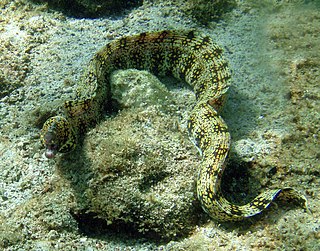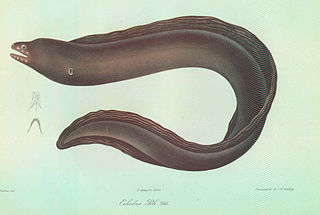
The barred moray, also known as the banded moray, the dark-banded eel, the girdled moray, the girdled reef eel, the many banded moray eel, the ringed moray, the ringed reef moray, the striped moray and the zebra eel,) is a moray eel of the family Muraenidae. It was described by John Richardson in 1845, originally under the genus Muraena. It is a marine, tropical eel which is known from the Indo-Pacific, including the Red Sea, East Africa, the Hawaiian Islands, the Marquesan Islands, the Tuamotus Islands, the Ryukyu Islands, and the Great Barrier Reef. It dwells at a depth range of 2 to 20 metres, and leads a benthic lifestyle in reefs and shallow lagoons. Males can reach a maximum total length of 72.3 centimetres (28.5 in).

The snowflake moray, also known as the clouded moray among many vernacular names, is a species of marine eel of the family Muraenidae. It has blunt teeth ideal for its diet of crustaceans, a trait it shares with the zebra moray.
Uropterygius concolor is a moray eel found in coral reefs in the Pacific and Indian Oceans. It was first named by Rüppell in 1838, and is commonly known as the unicolor snake moray, uniform reef-eel, brown reef-eel, brown moray eel, or the brown moray. It is mostly dull brown in colour, with the tip of the tail being yellow.

Uropterygius marmoratus is a moray eel found in coral reefs in the Pacific and Indian Oceans. It is commonly known as the marbled reef-eel, marbled eel, marbled snake moray, marbled moray, or the slender conger eel.

Echidna amblyodon, the Sulawesi moray is a moray eel found in the western central Pacific Ocean. It was described by Bleeker in 1856, originally under the genus Muraena. It is a marine, tropical eel which is known from Indonesia, in the western central Pacific Ocean. Males can reach a maximum total length of 20.5 centimetres (8.1 in).

Echidna delicatula, the mottled moray, also known as the fine-speckled moray, is a moray eel. It was described by Johann Jakob Kaup in 1856, originally under the genus Poecilophis. It is a marine, tropical eel which is known from the Indo-Pacific, including Sri Lanka, Samoa, and Japan. It inhabits coral reefs. It can reach a maximum total length of 65 centimetres (26 in).
Echidna leucotaenia, the whiteface moray, also known as the white-banded moray eel, is a moray eel. It was described by Schultz in 1943. It is a tropical, marine and freshwater eel which is known from the Indo-Pacific, including East Africa, the Line Islands, the Tuamotu Islands, and Johnston Island. It dwells at a depth range of 0 to 24 metres, and leads a benthic lifestyle in reefs. Males can reach a maximum total length of 75 centimetres (30 in).

Echidna nocturna is a moray eel found in the eastern Pacific Ocean, in the Gulf of California and around Peru and the Galapagos Islands. It was first named by Cope in 1872, and is commonly known as the freckled moray or the palenose moray. It was discovered that Echidna nocturna and Muraena acutis are the same species.

Echidna peli is a moray eel found in the eastern Atlantic Ocean. It was first named by Johann Jakob Kaup in 1856, and is commonly known as the pebbletooth moray.
Echidna unicolor is a moray eel found in coral reefs in the Pacific and Indian Oceans. It was first named by Schultz in 1953, and is commonly known as the unicolor moray or the pale moray. It is usually completely tan or light brown in color, aside from a dark ring around each eye.

Echidna xanthospilos is a moray eel found in the western central Pacific Ocean, around Indonesia and Papua New Guinea. It was first named by Pieter Bleeker in 1859. Its common names include yellow-spotted moray and skeletor moray.
The latticetail moray is a moray eel found in coral reefs in the Pacific and Indian Oceans. It was first named by Pieter Bleeker in 1857, and is commonly also known as the vagrant moray, Buru moray eel, or Buro moray.

The lipspot moray eel, also known as the textile moray, white-lipped moray or white-lipped reef eel, is a moray eel found in coral reefs in the Pacific and Indian Oceans. It was first named by Pieter Bleeker in 1864.

The blotch-necked moray eel is a moray eel found in coral reefs in the Pacific and Indian Oceans. It was first named by Pieter Bleeker in 1864, and is also commonly known as the blackpearl moray, pearly moray, pearly reef-eel, or the trunk-eyed moray.
Gymnothorax mccoskeri is a moray eel found in the western Pacific and the eastern Indian Ocean. It was first named by Smith and Böhlke in 1997, and is commonly known as the McCosker's moray, many-banded moray-eel, or the manyband moray.
The drab moray is a moray eel found in coral reefs in the Pacific and Indian Oceans. It was first named by Pieter Bleeker in 1856, and is also commonly known as the brown moray, monochrome moray, monotone moray, or plain moray eel.

The brown speckled eel or Steindachner's moray eel, Gymnothorax steindachneri, is a moray eel found in coral reefs in the eastern central Pacific Ocean, around Hawaii. It was first named by Jordan and Evermann in 1903. It is rarely seen in the wild due to its aggressive nature. It will lie waiting for a passing animal, and then ambush it.

The brown moray eel is a species of moray eel found in the eastern Atlantic Ocean and Mediterranean. It was first named by Delaroche in 1809.
The common false moray, false moray, grey reef eel, or plain false moray,, is an eel in the family Chlopsidae. It was described by Leonard Peter Schultz in 1943. It is a tropical, marine eel which is known from seaward reefs in the Indo-Pacific regions. It typically dwells at a depth around 56 metres (184 ft). Males can reach a maximum total length of 30 centimetres (12 in).
Kaupichthys hyoproroides, the false moray, common false moray, grey reef eel, reef eel, plain false moray, or double-toothed xenocongrid eel, is an eel in the family Chlopsidae. It was described by Pehr Hugo Strömman in 1896, originally under the genus Leptocephalus. It is a subtropical, marine eel which is known from coral reefs and rocky shores in the western Atlantic Ocean, including southeastern Florida, USA; the Bahamas, Yucatan, Mexico; the Antilles, and Venezuela. It is a benthic, solitary eel that typically dwells at depths to 95 m. Males can reach a maximum total length of 30 cm.










